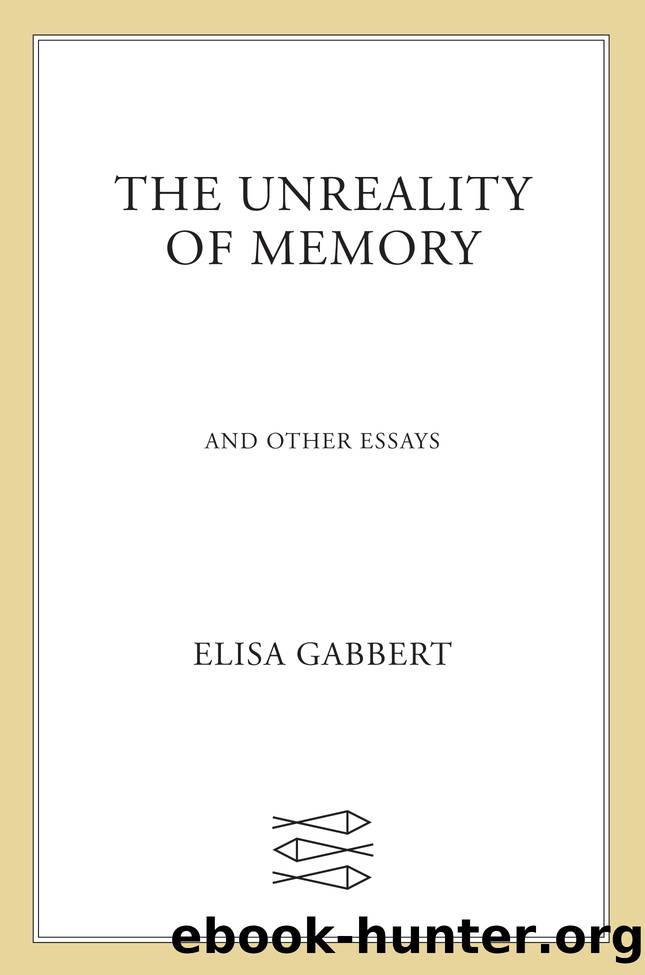The Unreality of Memory by Elisa Gabbert

Author:Elisa Gabbert
Language: eng
Format: epub
Publisher: Farrar, Straus and Giroux
Placebo Effect
The symptoms of “hysteria” on record often read like conditions of somatic, not psychogenic, origin—like indigestion from wearing corsets, or endometriosis, or irritable bowel syndrome, or migraines. (Oliver Sacks’s book on migraines suggests they can cause almost any symptom at all, from nausea to partial blindness to an acute and uncanny fear of death. Blaise Pascal would report the sense of a “precipice” “yawning” on his left-hand side—his friends called it l’abime de Pascal, Pascal’s abyss.) But we now know, the thinking goes, that what the patients really had was conversion disorder, because they responded to bogus treatments. Shorter cites a woman in Bath in 1663 who suffered from debilitating weakness and joint pain. After “a vigorous round of enemas, laxatives, and bathing,” she felt well for ten years—at which point she developed gout. Some of the more ludicrous treatments that “worked” to cure hysterics were the burning of feathers or asafetida (a pungent ingredient common in Indian food, it means “fetid resin”) to somehow “treat the uterus,” as though to smoke the monster out, and unnecessary, voluntary surgeries—there was a fad for a while of removing the ovaries, called Battey’s operation. Women would supposedly beg or demand to be “Battey-ized.”
There were also, however, involuntary surgeries, such as clitoridectomy, basically genital mutilation, performed as a cure for nymphomania, “which usually meant chronic masturbation,” Shorter writes. In a “typical case from Paris” (he quotes from the case history): “A young woman was so given to masturbation that she was close to dying from exhaustion … In vain her hands were tied.” They literally tied her up, but “she was able to gratify herself by rubbing against some protuberant part of the bed.” (Perhaps this young woman had been abused? Children who are sexually abused often masturbate obsessively.) The case notes claim the patient and her parents both “readily agreed” to “amputation of the clitoris.” The doctor “resected the organ with a single knife stroke” and then cauterized the wound with a hot iron. They pronounced her cured. (She probably did stop masturbating, or at least seeking medical help.)
In 1836, William Roots, a doctor on staff at St. Thomas Hospital in London, told a group of medical students: “You all know that nothing is more common, when a woman is hysterical, than to see her relieved for a time by the burning of feathers under her nose.” But what Roots is describing is the placebo effect, which works for “real” illnesses too. When you are sick or in pain, being offered treatment—being taken seriously—itself offers a measure of relief. Responding to silly or arbitrary treatments would not preclude all “hysterics” from having somatic conditions. The placebo effect is especially strong when both doctor and patient believe the treatment to be effective. Some common drugs appear to work only when patients know they are taking them; a 2003 paper reported that diazepam, commonly known by the brand name Valium, has no effect on anxiety when administered secretly through a drip. But people who willingly take diazepam report significant reduction in anxiety.
Download
This site does not store any files on its server. We only index and link to content provided by other sites. Please contact the content providers to delete copyright contents if any and email us, we'll remove relevant links or contents immediately.
The Fine Print (Dreamland Billionaires Book 1) by Lauren Asher(2395)
Fury of Magnus by Graham McNeill(2362)
The Last House on Needless Street by Catriona Ward(2180)
The Rose Code by Kate Quinn(2073)
Malibu Rising by Taylor Jenkins Reid(1803)
Luster by Raven Leilani(1800)
Transcendent Kingdom by Yaa Gyasi(1770)
A Little Life: A Novel by Hanya Yanagihara(1741)
Moonflower Murders by Anthony Horowitz(1719)
The God of the Woods by Liz Moore(1562)
The Lost Book of the White (The Eldest Curses) by Cassandra Clare & Wesley Chu(1510)
This Changes Everything by Unknown(1421)
The Midwife Murders by James Patterson & Richard Dilallo(1376)
The Lying Life of Adults by Elena Ferrante(1348)
The New Wilderness by Diane Cook(1333)
Written in the Stars by Alexandria Bellefleur(1317)
Wandering in Strange Lands by Morgan Jerkins(1281)
Ambition and Desire: The Dangerous Life of Josephine Bonaparte by Kate Williams(1274)
The Lying Life of Adults by Elena Ferrante;(1231)
